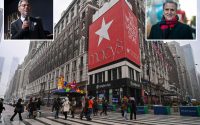New York City’s hotel industry remains confusing with ‘misleading’ data
The health of the city’s hotel industry is a crazy-quilt pattern of mostly optimistic but confusing and conflicting cross-currents. Large new hotels continue to open even as famous old ones close for good. Occupancy’s way up over 2021 but still below pre-Covid times.
Meanwhile, an uptick in the crucial industry metric known as RevPAR, or revenue per available room, is welcome but not nearly as much as it should be, according to Hotels Association of New York City (HANYC) chief executive officer Vijay Dandapani.
He argues that the biggest obstacle to full-scale recovery is the hotel occupancy tax. The whopping 5.875% levy on every guest deters many from coming here, especially event planners for large groups — “If you’re planning an event to come to Madison Square Garden to see NCAA basketball, for example,” Dandapani said.
His organization is lobbying the city to slash the tax to 2.875% for at least two years. In June of 2021, the city under former mayor Bill de Blasio dropped the tax entirely for only three months — “not enough to do much good,” Dandapani said.
The inn industry was once relatively simple to track, but pandemic disruption and simultaneous surges in new openings and closures made it as confusing to grasp as a subway map is to first-time visitors.
Look at the new Virgin, Ritz-Carlton and Hard Rock, beautiful additions in prime locations! But avert your eyes from the dark Four Seasons on East 57th Street, hostage to an opaque dispute between owner Ty Warner and operator Four Seasons.


Try, too, to ignore the sorry spectacle of the Chinese-owned Waldorf-Astoria, which, as we reported this week, might not open before 2025.
Of a dozen up-market Manhattan hotels that closed after Jan. 1, 2020, only three have firm plans to reopen, according to an analysis prepared for CBRE by Lodging Econometrics. They are the uptown Four Seasons, the former Roger on Madison Avenue (to reopen in May as AKA Nomad), and the Surrey on East 76th Street, rebranded as Surrey, a Corinthia Hotel (timing unknown).
The permanently shuttered include the Bryant Park, AKA Wall Street, Marriott East Side, the Roosevelt and the Hudson. The list doesn’t even include the Waldorf-Astoria, which went dark in 2017, or include the huge, lower-rent Pennsylvania, which is being demolished.

The city is hyping a significant increase in visitors — a projected 61 million this year compared to 56 million in 2022, and approaching the record 66 million in 2019. There’s even been a jump in visitors from China, typically the biggest spenders on luxury goods, restaurants and entertainment, since the country’s borders reopened.
Occupancy in 2022 was 75%, still below the pre-COVID average of 86% but vastly more than in the bleak days of 2020 and 2021.
But Dandapani said the upbeat numbers are misleading. Overall, he said, the Big Apple currently has about 118,000 open hotel rooms, down from 126,000 pre-pandemic — despite the addition of 6,000 newly constructed rooms in the past two years.
The theoretically “open” rooms include around 9,000 which are being used to house migrants who ended up in the city. They’re counted as “occupied.”
As for RevPAR, PwC’s Manhattan Lodging Index found that it increased in the fourth quarter of 2022 year-over-year by 54%.

But Dandapani said that New York RevPAR lags “cities that are primary competitors to us.” In troubled Paris from which Dandapani just returned, for example, RevPAR rose 15% in 2022 over 2019 and in London by 7%. In New York City, RevPAR was still $4 less on average compared with 2019” — a dip from $219 to $215, “and that was not adjusted for inflation,” he added.
Moreover, he said, the recent RevPAR upticks mainly benefitted the luxury-end of the market.
He attributed it to so-called “revenge” travel,” reflecting pent-up demand to travel by the wealthy who were stuck at home during lockdowns and border restrictions. “It’s a fact that the rich got richer during the pandemic,” Dandapani said.


